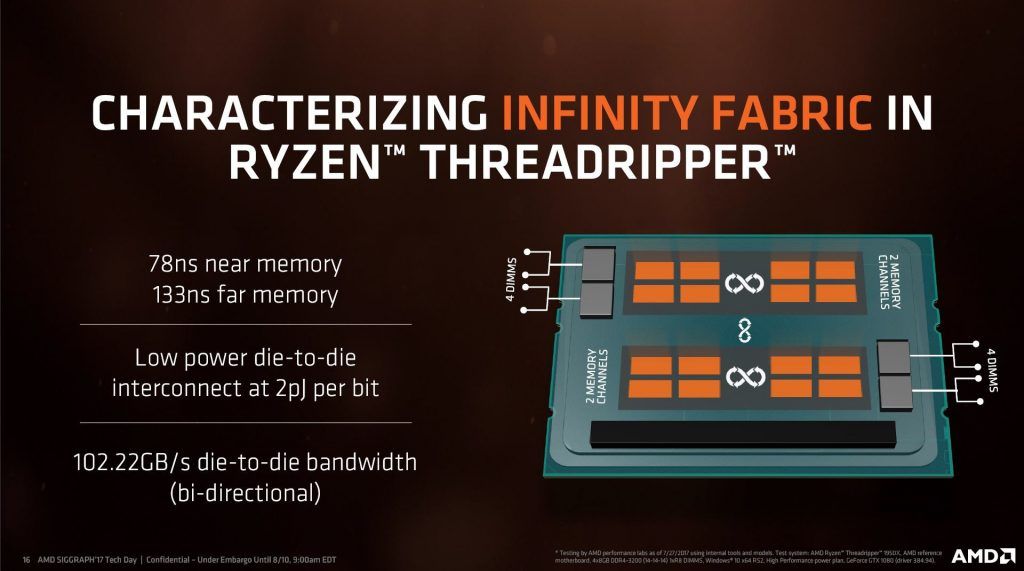If we went a few moments ago, we told you that AMD had selected its best slots for the new processors AMD Ryzen Threadripper. And now it’s time to explain how the memory works and the PCIe lines in this different new processor.
Ryzen Threadripper How Memory Works in AMD Threadripper
AMD has detailed how memory works in AMD Ryzen Threadripper. Each of the two slots has two memory channels. So, giving shape to the four channels of memory available in the final processor. That means that a single slot can directly access two of the memory channels. Or what is the same to four of the DIMMs installed in them. And consequently, to access the other two channels this access passes through Infinity Fabric generating with some latency. The difference between latencies versus direct and indirect use is 66.2ns to 86.9ns, 20ns. That can mark some performance differences as expressly AMD in an own benchmark that you can see next to the other information presented in slides.
Intel Core i9 7960X Knockout AMD Threadripper 1950X in Geekbench 4
For the hardware, four 8GB DIMMs installed in the four channels shows as 16GB mounted in each of the slots. And this is a dual-socket platform these shows as 32GB installed as on any other platform. What in practice contributes to the bandwidth of the four channels with the only difference of the problem of latencies versus access to the memory installed in the slots.
Ryzen Threadripper UMA and NUMA Access Modes
AMD has prepared two access modes such as UMA and NUMA. The UMA is the distributed model that focuses only on providing the highest performance. And regarding bandwidth making the cores of a slot access each other’s memory slot. While NUMA is about the latency-centric model, forcing a slot to access its own installed memory. So the software can be optimized for UMA or NUMA according to your needs. Or in the case a default UMA, it will be used with the small latency problem, which does not seem too dangerous.
Dell New Alienware Area 51 Includes Support for Ryzen Threadripper
On the side of the PCIe lines, we have a similar case, AMD Ryzen Threadripper has a total of 64 PCIe lines. So, each slot itself manages 32 of those lines PCIe 3.0. But the distribution of the same catch the attention. Four of the PCIe 3.0 lines remain allocated to the X399 chipset, while the next 32 lines are assigned to two PCIe 3.0 ports. So, that allows 16x/16x multi GPU configurations, leaving a total of 28 free PCIe lines. The open lines allow to install up to two additional GPUs at 8x and up to three M.2 ports with four lines reserved for each. Or in a more extreme case install up to 6 GPUs with eight lines each leaving four free lines for one M.2 PCIe x4 drive.
That opens doors to all sorts of configurations on this platform and outperforms Intel with its X299 enthusiast platform. AMD here wanted to minimize the problem of GPU access latencies by offering the 32 PCIe 3.0 lines from a single slot to make the most common multi GPU configurations to reach their maximum performance.
Ryzen Threadripper Low Latency
We will have to see how AMD Infinity Fabric works in a much larger processor with two different slots. That is still connected to a bi-directional channel by this method while internally each slot has two CCX totaling a total of four. AMD, for now, has not mentioned whether its enthusiast platform somewhat improves the theme of Infinity Fabric latencies.
